Let’s be honest: For most of us, all we need in life is a trail bike. We like to rip up our home trails, and we often sit on the saddle for hours on end, relying on our own human power to get up hills, simply to enjoy the view from the top and to seek fun and flow on the way back down. The bikes in this comparison are made for the adventures of everyday life!
Before you buy a new bike, you should ask yourself: what kind of riding do I do most often, and what kind of riding do I want to do? Do I (or will I) really sit in a shuttle or gondola every weekend? Am I actually riding on trails that would easily pass as stages of the Enduro World Series? If you answered yes to any of these questions, this is not the review for you. If you answered no, however, the trail bikes in this comparison are just the ticket!
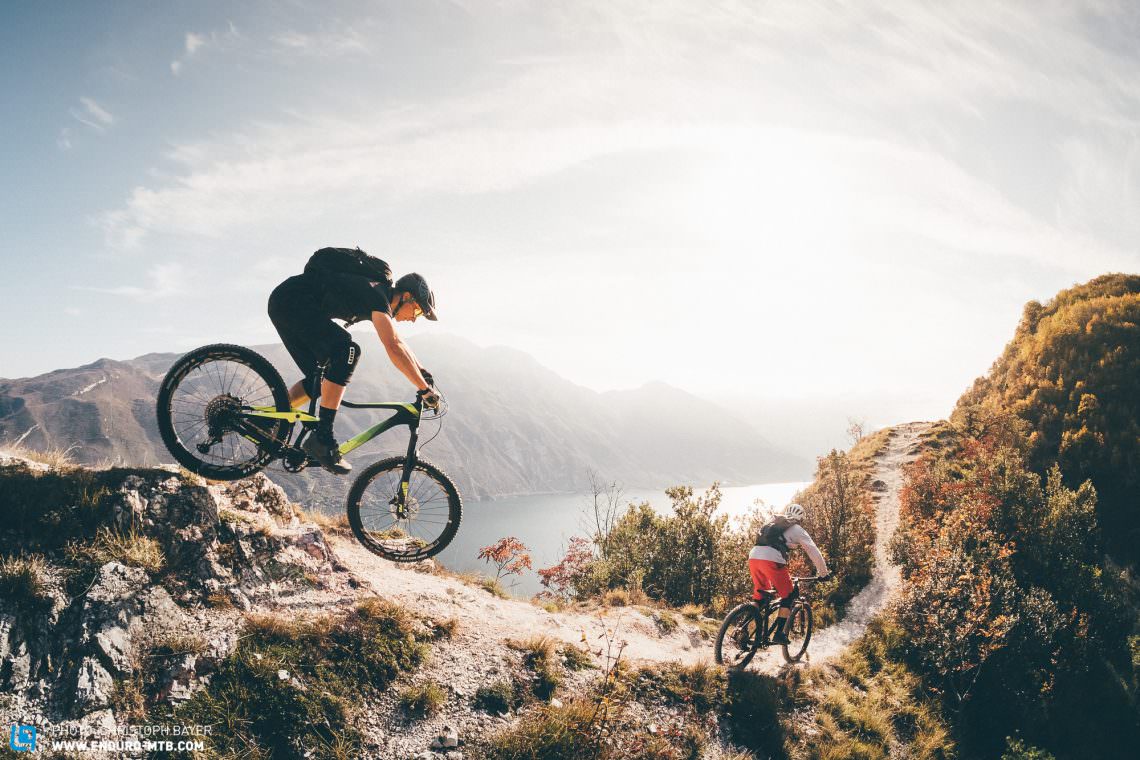
Trail bikes have evolved into true all-rounders. They are so versatile nowadays that even enduro pros rely on them time and again at the Enduro World Series. While chugging around everywhere on an enduro bike often is overkill, trail bikes are the better choice for most riders. They’re agile, quick to get up to speed, and they give you feedback from the trail, meaning they’re more likely to put a grin on your face than heavier, longer-travel bikes. That being said, the differences between individual models are huge. What we were looking for was a bike you could race a marathon on in the morning, and then in the afternoon race an enduro.
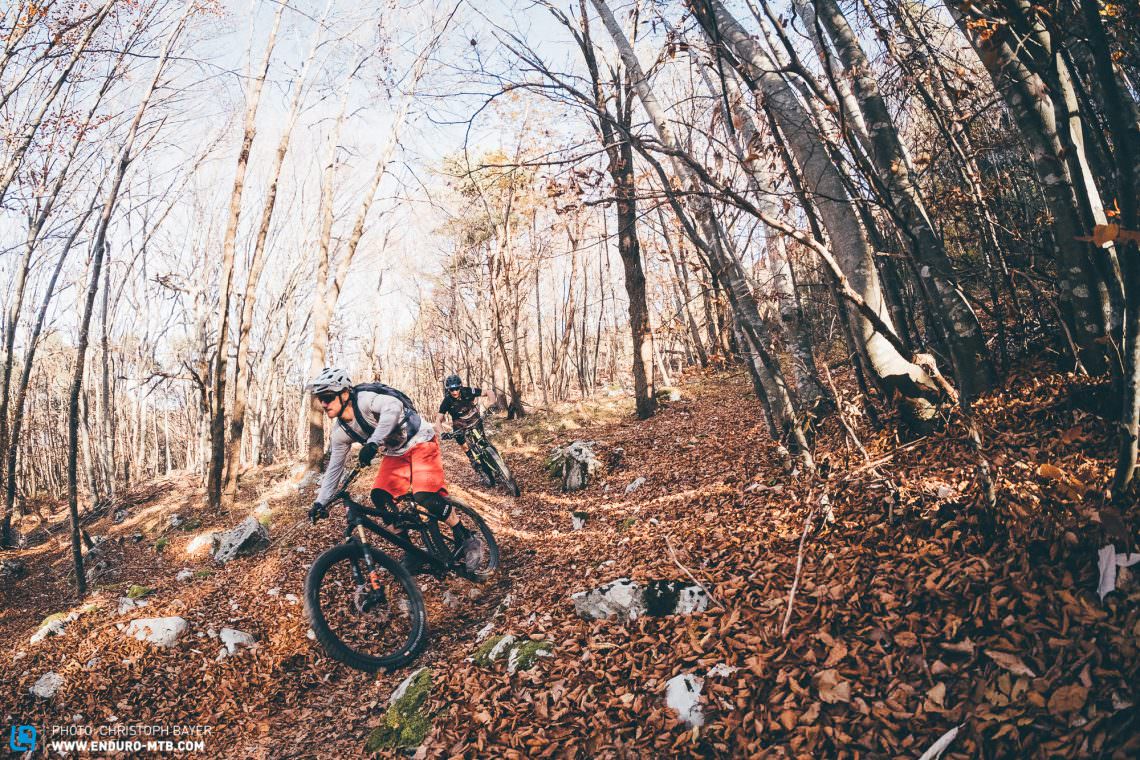
Numbers on a piece of paper
The bikes in this comparison could not be more different. Although they all fall into the same category, looking at them on paper, you wouldn’t think so. Here’s a first look at the numbers by themselves:
Price
Average price
€ 7,924
Most expensive bike
SCOTT Genius – € 9,799
Most affordable bike
NICOLAI G13 – € 5,949
Wheelbase
Longest wheelbase
1,296 mm – NICOLAI G13 (L)
Shortest wheelbase
1,173 mm – Trek Fuel EX (M)
Wheels
Wheel sizes tested
27.5, 27.5+, 29”
Weight
Average bike
12.53 kg
Lightest bike
SCOTT Genius – 11.72 kg
Heaviest bike
NICOLAI G13 – 14.03 k
Reach
Longest reach
510 mm – NICOLAI G13 (L)
Shortest reach
431 mm – Specialized Stumpjumper (L)
Travel
Longest travel (rear)
150 mm – SCOTT Genius
Shortest travel (rear)
130 mm – Trek Fuel EX/NICOLAI G13
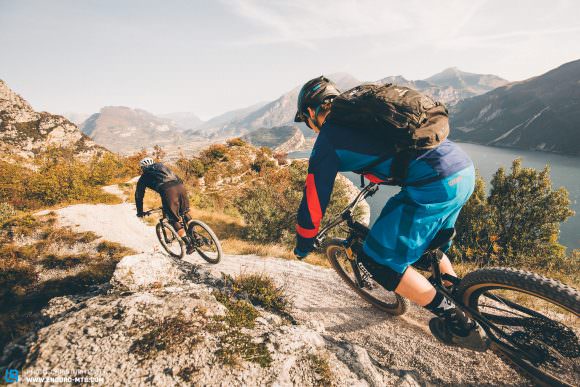
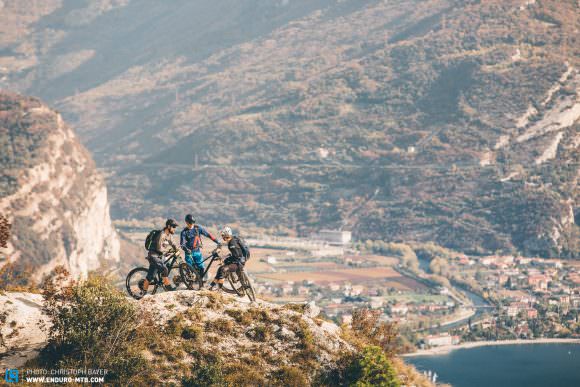
What matters is the overall concept
Instead of just making comparisons on paper, it’s much more important to take a closer look at the overall design of the bikes – and that’s exactly what we did in this comparison. Ultimately, the isolated consideration of travel does not say anything about the capabilities or the handling of a bike. Geometry data alone also does not speak the whole truth, a fact that stood out once again in this review. Here are some exciting insights from our test sessions.
| Bike | Price | Weight | Travel (f/r) | Wheelsize |
|---|---|---|---|---|
| Giant Trance Advanced 0 | € 6,999 | 12.33 kg | 150/140 mm | 27.5″ |
| Liteville 301 MK14 All Mountain | € 7,800 | 12.08 kg | 140/140 mm | 27.5″ |
| Nicolai ION-G13 QLFLINE | € 5,949 | 14.03 kg | 140/130 mm | 29″ |
| Scott Genius 700 Ultimate | € 9,799 | 11.72 kg | 150/150 mm | 27.5+ |
| Specialized S-Works Stumpjumper 29 | € 8,999 | 12.88 kg | 150/135 mm | 29″ |
| Trek Fuel EX 9.9 29 | € 7,999 | 12.15 kg | 130/130 mm | 29″ |

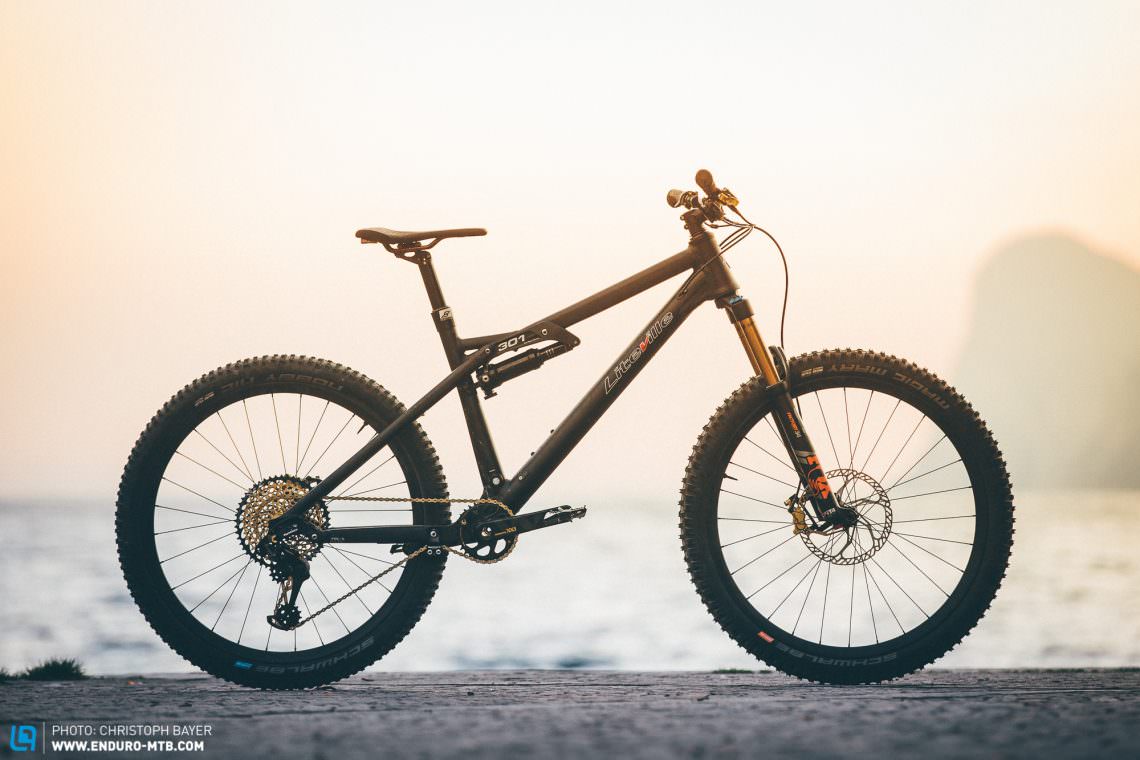
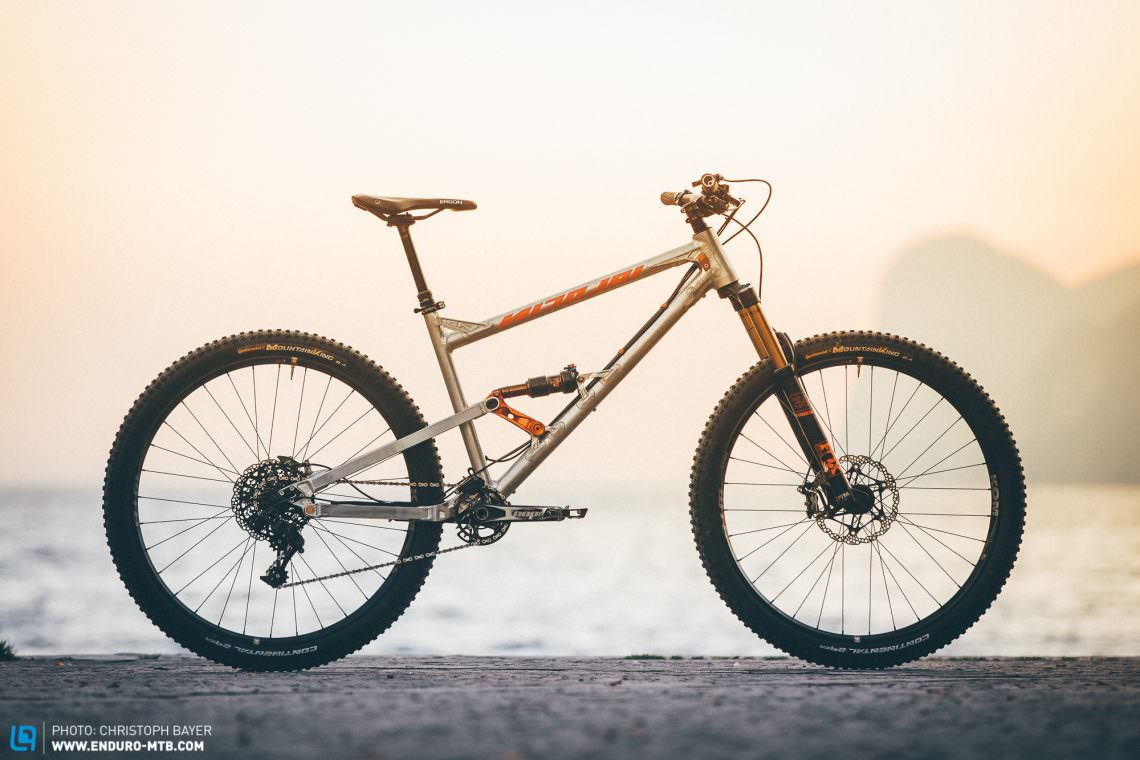

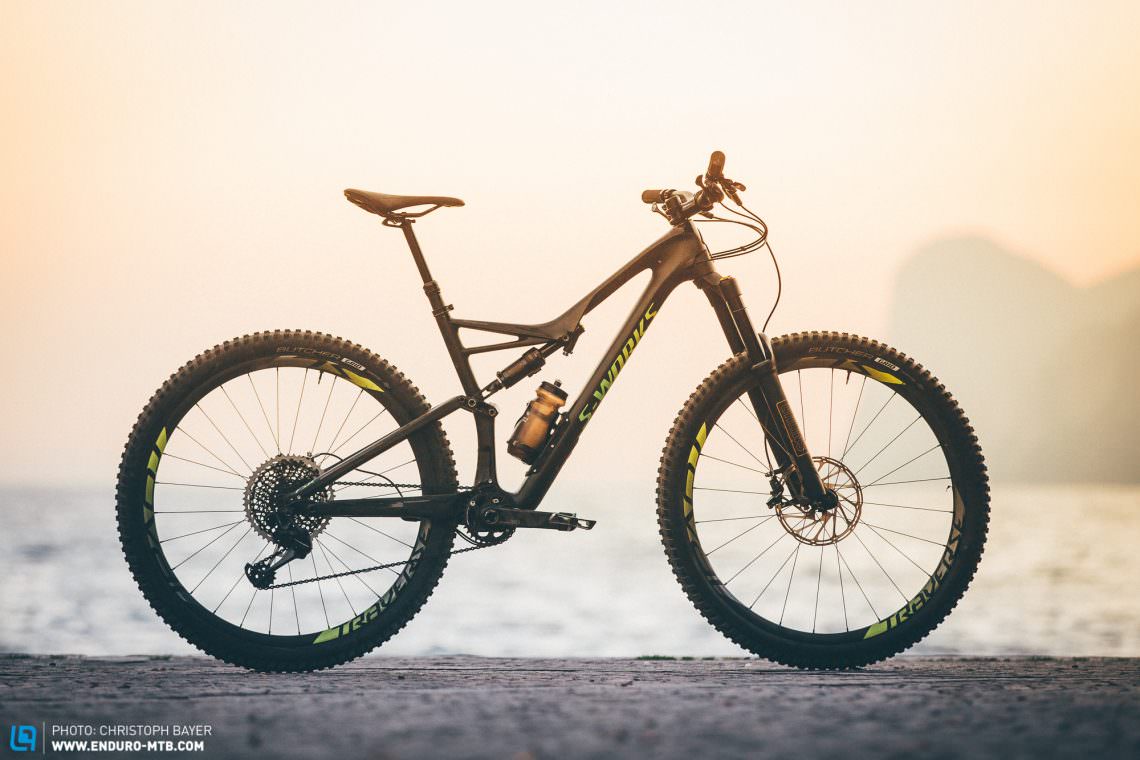
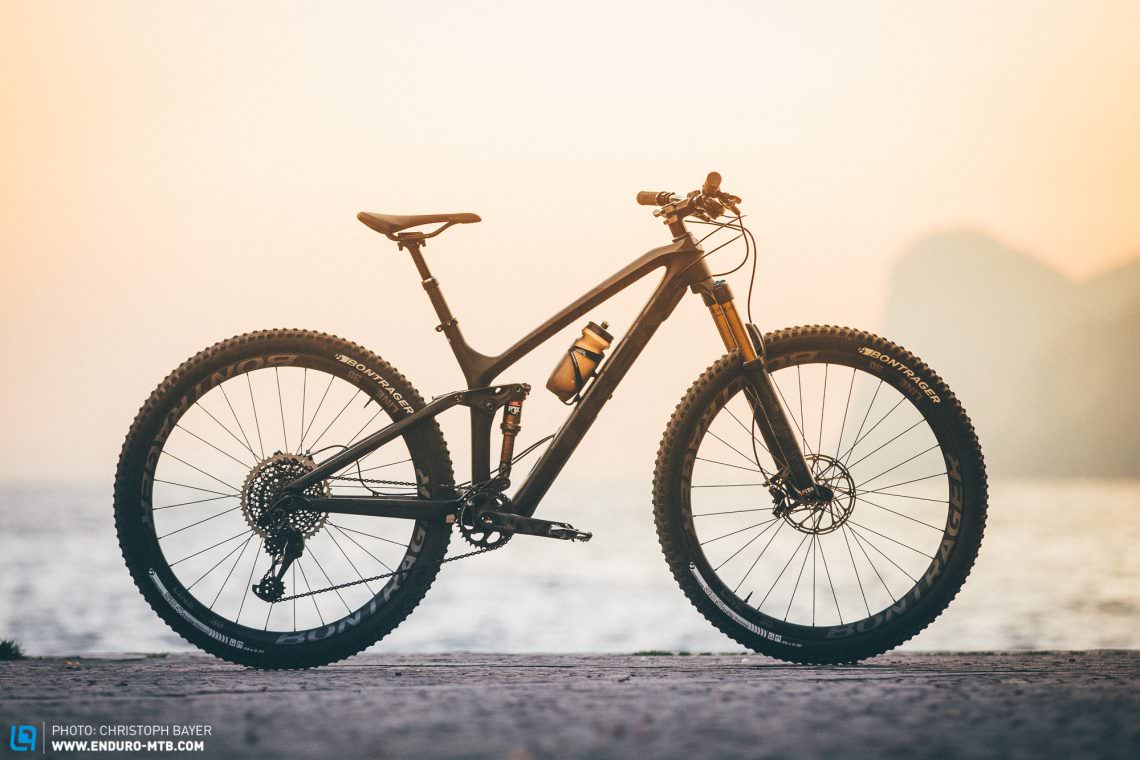
Uphill is more than just a means to an end with these bikes
Let’s be honest: a ride can be as epic as ever, but if after an hour your back hurts and your ass is burning, it’s just no fun! However, the best trails hardly ever start right next to the cable car at the top of a mountain; they have to be earned. Thus it goes without saying that apart from the downhill performance of a trail bike, its climbing capabilities are crucial! For many years, people believed that the weight and stiffness of a bike were the deciding factors for efficient climbing. Instead, it depends on the rider’s position on the bike, as well as comfort and suspension/pedalling efficiency.
Regarding uphill performance, the SCOTT Genius 700 Ultimate with its brutally efficient suspension, sporty seating position, and low weight (11.72 kg) catapults to the top. It accelerates so willingly that one almost involuntarily bursts out in sprints, and it constantly goads you to put out a few more watts. Nevertheless, it is very comfortable even on long climbs, and in technical sections, it convinced us with a lot of traction. The SCOTT is closely followed by the Liteville 301 MK14, which scores with a very centred seating position thanks to its steep seat tube angle. Both bikes are at the top of the podium in terms of climbing performance. Lagging slightly behind are the Trek Fuel EX 9.9 29, the Specialized S-Works Stumpjumper, and the Giant Trance Advanced. The Trek’s slack seat tube angle puts riders with long legs a little too far behind the rear wheel. The Specialized S-Works Stumpjumper is supremely comfortable, though it could do with more efficient pedalling characteristics. The Giant also performs solidly uphill, but it isn’t quite as light-footed as the two climbing champions. The NICOLAI G13 is at the bottom of the climbing scores. With its very long front triangle and steep seat angle, the rider’s seating position is brilliant, but it’s held back by a lack of gear range and its weight (14.03 kg).
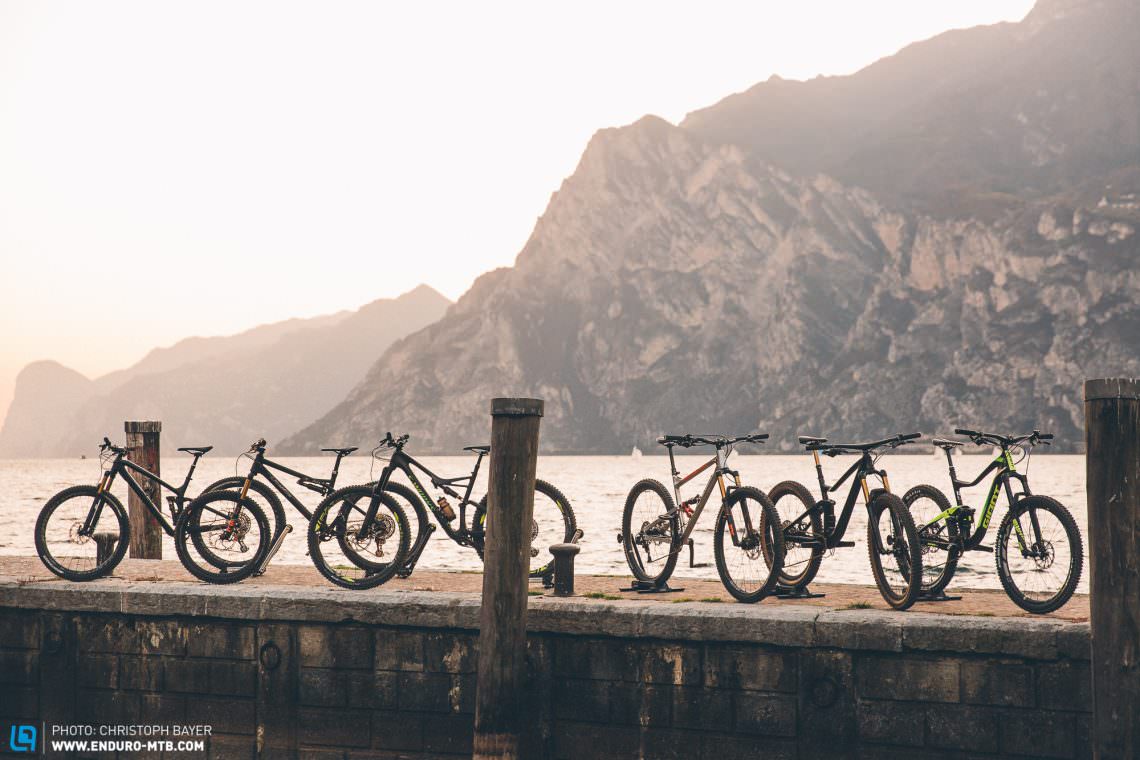
“Modern” geometry as a guarantee for downhill fun
Here are some phrases we’re sick of hearing: “modern geometry,” “aggressive handling,” and our favourite, “long and slack.” However, the fact is that the evolution of bike geometry – much like regular evolution – is and always has been a long, slow, and ongoing process! There are bikes that have stayed virtually unchanged for years, and others with extremely radical geometry. Prime examples of these two categories are the NICOLAI G13 and the Specialized Stumpjumper. Their geometry data doesn’t differ only by a few millimetres, but by whole centimetres – in terms of bike geometry, we’re talking different galaxies! Nevertheless, their speed on the trial is almost identical. How come? The magic word in geometry is balance! What is decisive for a bike’s handling is not a single value on the geometric table, but the interaction of them all – and this works for both the Specialized and the NICOLAI. Having said that, there is a clear trend. Head tube angles are becoming slacker, front triangles are becoming slightly longer, and in the case of chainstay length, a middle ground usually proves to be ideal.

How and where were the bikes tested?
These bikes are proper all-rounders, so they had to prove that in this comparison. We not only compared the bikes head-to-head around Lago di Garda, but also rode them extensively on our local trails in the Chiemgau Alps and the Samerberg Bikepark. Apart from downhill performance, their climbing qualities also played an important role in this test.
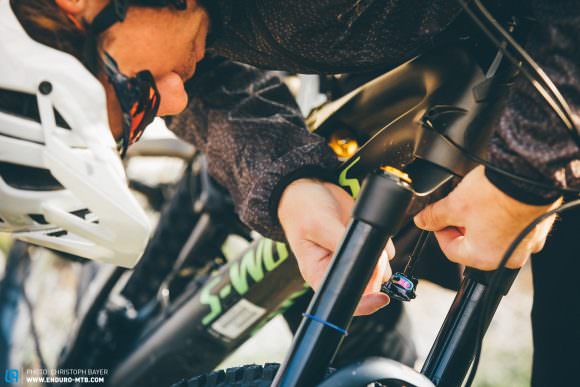

The suspension is essential
There is another factor that has a noticeable effect on handling that you cannot read from the geometry table: suspension performance. No matter how good the geometry is, if the front or rear suspension don’t play along, a bike will never reach its full potential. Also decisive for short-travel bikes is small bump sensitivity and the associated traction. The suspension shouldn’t wallow, and should provide enough feedback and end-stroke progression. The best performing suspension on the downhills in this comparison is that of the Specialized S-Works Stumpjumper. The Öhlins shock responds very sensitively and absorbs every irregularity in the trail. However, the Öhlins suspension fork requires a bit of patience and know-how to reach the optimal setup. On the Giant Trance Advanced, the interaction of the Maestro rear triangle with its new RockShox Super Deluxe Shock and PIKE in front is outstanding too. The SCOTT Genius is a bit harsher in direct comparison, but not insensitive, and its pedalling efficiency continues to impress. The rear triangle of the Trek Fuel EX, with its new Thru Shaft technology, is right up there among the best (Although the 130mm Fox fork on the Fuel EX could do with a bit more travel.) The linkage of the NICOLAI G13 is very progressive, which means that the rear end noticeably firms under fast, hard blows. The Liteville 301 goes through its travel too easily and wallows in turns; at speed, the bike becomes restless and feels a little undefined.

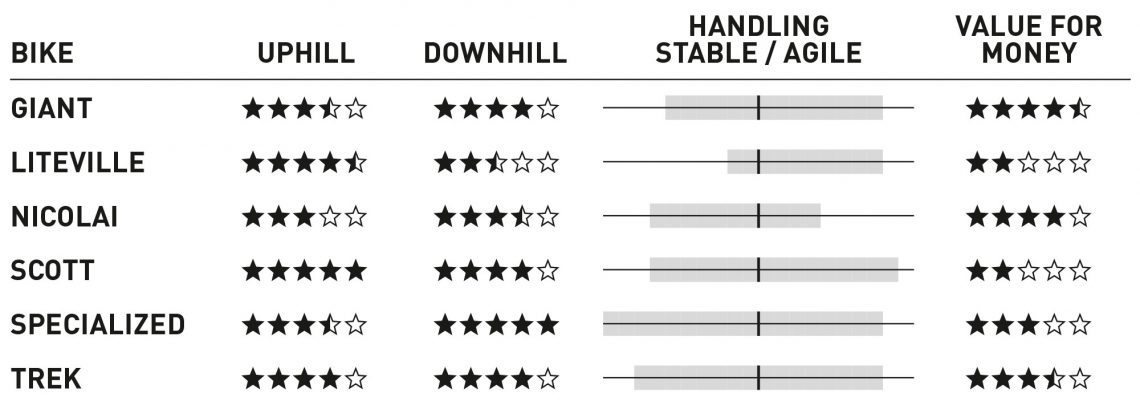
The limiting factor: the components
The bikes in this comparison are drool-worthy machines that cost more than many of us would spend on our car. One can and must expect perfection. While the geometry and the suspension of the bikes we compared mostly worked superbly, they, unfortunately, let weaknesses creep in via the componentry. If you spend a little less than € 8,000 on a Trek Fuel EX, you will not be pleased by a rattling dropper post. The same applies to the Specialized Stumpjumper, where the Command Post with only 125 mm stroke significantly limits one’s range of motion. The topic of tires also remains hot in 2017: the Continental Mountain King, for example, does not do justice to the performance of the NICOLAI G13. In the individual reviews on the following pages, we did a detailed analysis of all the bikes’ strengths and weaknesses to find out which bike is best for what kind of rider.
Tops & Flops
Often small details can make a huge difference: seamless integration, first-class ergonomics and carefully selected parts. Easier said than done – here are some of the tops and flops from this grouptest.
Tops
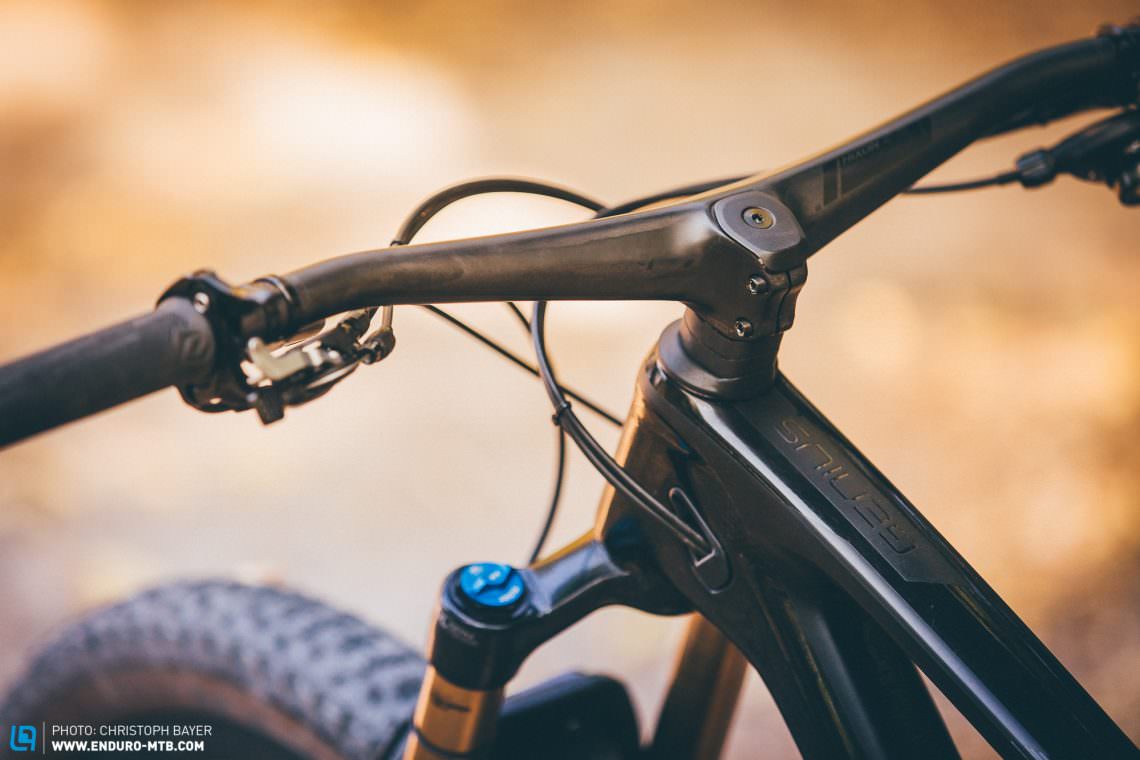
This is what a cockpit should look like in 2018: the futuristic look of the Syncros Hixon cockpit excites us. However, the handlebar could be a bit wider.
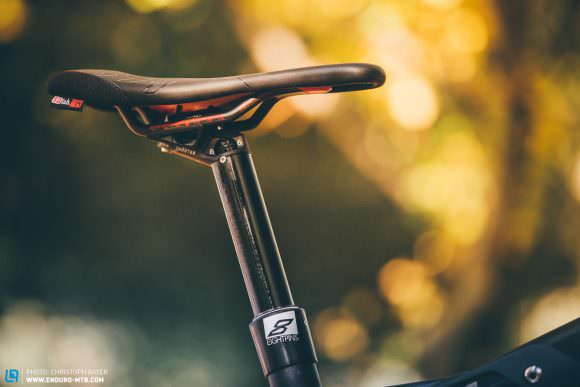
The EightPins seatpost impressed with its outstanding function and the enormous stroke range. Unfortunately, the frame has to be compatible. We are curious to see if more manufacturers are going to include these in their frames.
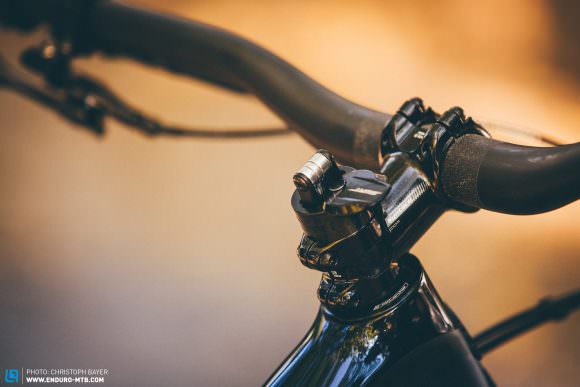
In addition to the SWAT box in the down tube, Specialized has an integrated mini-tool in the head tube. Apart from the mini-tool, which can be quickly removed, you will also find a chain tool (including a quick-link)
Flops
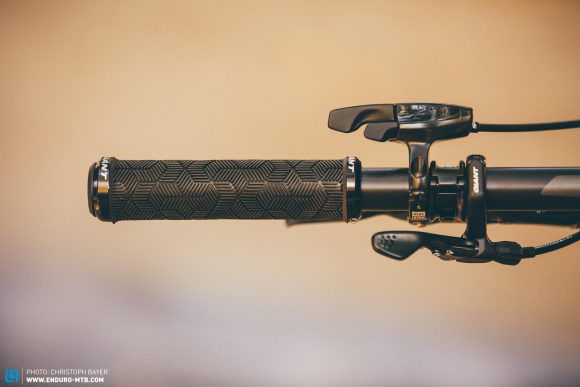
The cockpit of the Giant looks cluttered. In particular, the remote lever for the RockShox shock could be integrated a bit neater.
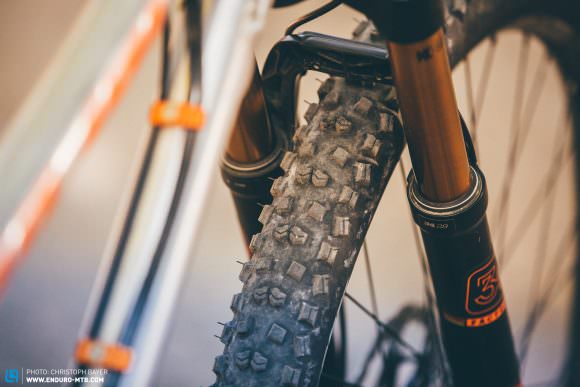
The Continental Trail King tires lacked grip (and they’re not easy to mount tubeless either).

The bolted chainstay protection might look nice, but the material has no damping properties, amplifying chain slaps instead.
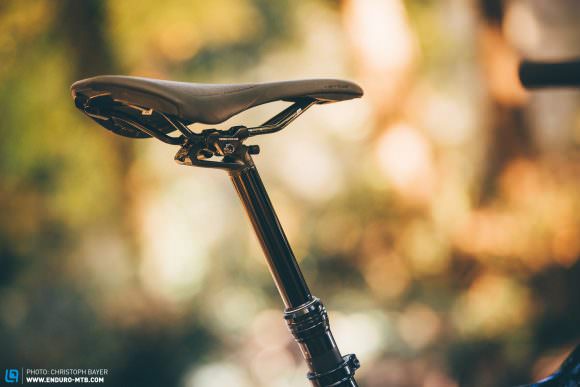
Although the Specialized Command Post works very reliably, it not only has too little stroke, but is also offset in a way that pushes the rider back towards the rear wheel.
Which is the best high-end trail bike?
The decision in this comparison was truly not an easy one. In principle, three bikes would have scored full points: the SCOTT Genius 700 Ultimate, the Specialized S-Works Stumpjumper, and the Trek Fuel EX 9.9 29. But in the end, there can only be one winner. The Stumpjumper offers the best downhill performance and delights with smart features like the further-improved SWAT system, but it falls behind on the uphills. The Trek Fuel EX delivers a terrifically balanced handling package but shows weaknesses in the componentry. In the end, it’s the brand-new SCOTT Genius 700 Ultimate that impressed our testers the most with its outstanding uphill efficiency, great downhill performance, its versatility and, last but not least, its stunning looks. The price for this posh bike, however, is more than ridiculous: the top of the range Genius will set you back by € 9,799. Our Best Value Winner, therefore, is the Giant Trance Advanced 0. Anyone who is prepared to accept a small penalty in climbing efficiency will be rewarded by a bike with a terrific rear suspension, well-balanced handling, and reliable components at a price of € 6,999.
All bikes in test: Giant Trance Advanced 0 | Liteville 301 MK14 All Mountain | Nicolai ION-G13 QLFLINE | Scott Genius 700 Ultimate | Specialized S-Works Stumpjumper 29 | Trek Fuel EX 9.9 29
Lago di Garda Hotel tip
For our test rides around Lake Garda, we were supported by the Santa Lucia hotel in Torbole. Those looking for a fancy, mountain bike friendly hotel on Lake Garda will find it there! Delicious breakfasts, newly renovated rooms, a supervised bike storage room – what more could a biker’s heart want? More information is available on the hotel website.
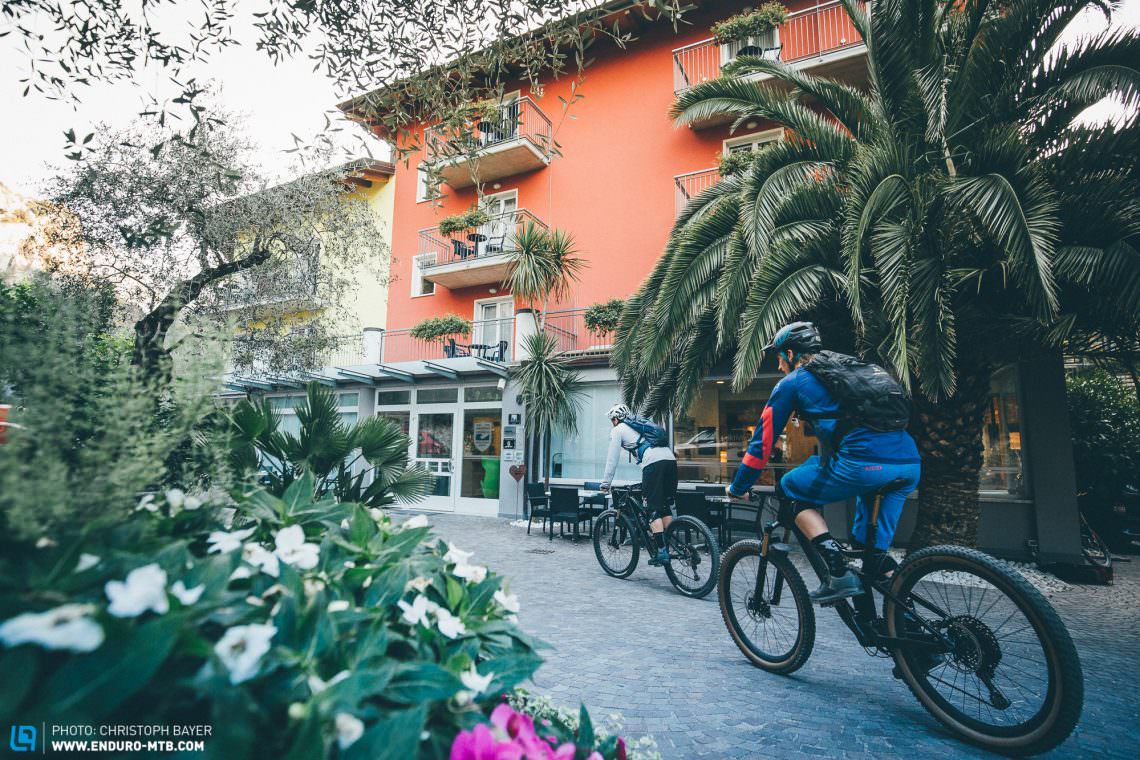
This article is from ENDURO issue #031
ENDURO Mountainbike Magazine is published in a digital app format in both English and German. Download the app for iOS or Android to read all articles on your tablet or smartphone. 100% free!

Did you enjoy this article? If so, we would be stoked if you decide to support us with a monthly contribution. By becoming a supporter of ENDURO, you will help secure a sustainable future for high-quality mountain bike journalism. Click here to learn more.
Words & Photos:













